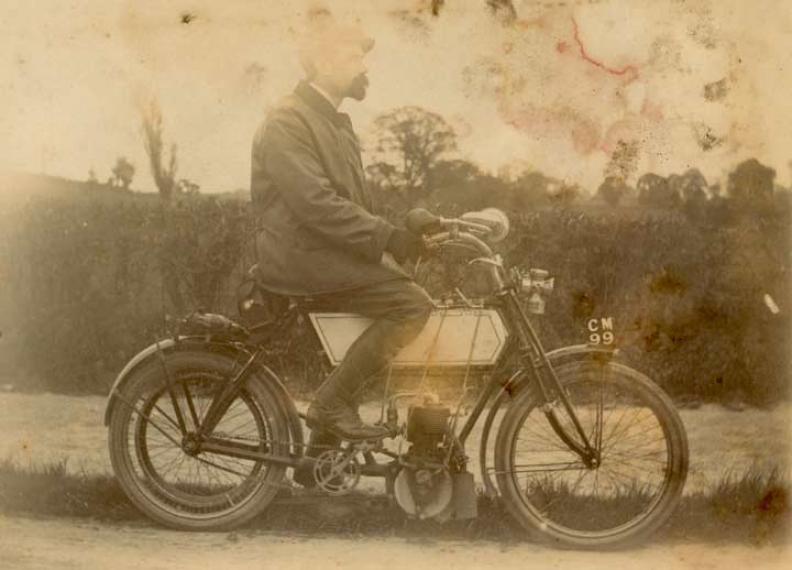1905 Chater Lea Pictures
Add Your Photos!Very many thanks to Andy Breeden for this picture. Andy recently bought this picture on eBay and it came with a letter from Titch Allen stating that the bike is a 1904 Triumph, with a Belgian 2 1/2 HP Minerva engine and a French Longuemare carb.
However, it would seem that this is probably not the case….
Leon says: “The motor in the bike is not a Belgian Minerva, but instead a German Fafnir. Minerva were early adopters of mechanical inlet valves, so any of their in-frame engines have both valves at the side. The big clip-on of 1903 was the last Minerva catalogued with an atmospheric inlet valve. The carburettor doesn’t look much like the period Longuemare. It’s probably Fafnir’s own, which was a close copy of the FN item. The cycle parts of the bike are “pure” Chater Lea, which would have been sold as a kit to anyone who wished to build a bike. So is the bike a Triumph? Triumph are said to have built a Fafnir-engined bike around 1904. Did this machine use Chater Lea cycle parts? If so, the photo might be of a Triumph-Fafnir c1904-5, but there would have been other firms using the same motor/frame combination.
Howard’s illustration at the bottom of the page is a beauty – it is of course the same Fafnir engine, but as you point out the Triumph cycle parts are quite different. Unfortunately without a big hint it’s almost impossible to identify the bike in the original photo, which is a pity. The Triumph-Fafnir is said to be 1904 – I’d guess that the Fafnir-Chater Lea is c1905-06.”
And thanks also to Howard for sending the picture at the bottom for comparison. It is clear there are differences betwee the two bikes (the latter certainly being a Triumph).
And thanks also to Peter Cornelius (the VMCC Triumph Marque Specialist) for his comments:
“I agree that the bike in the (super) picture is not of a Triumph. Triumph’s early Minerva and JAP engined machines had the engines mounted as an attachment at the front of the forward down-tube. (Pictures in my booklet on the 1902-15 Early Models. List attached.) The engine in the picture is the German Fafnir made at the Aix-la-Chapelle (now Aachen) Steel Works, and it doesn’t look to have the Longuemare carb. However, the two main items which do not identify it, to me, as Triumph are (1) it hasn’t the charactaristic pattern pedal chainwheel which Triumph used, and (2) Triumph used the external band rear brake which they had used on their pedal cycles. (Both items to be seen on the other picture, and I cannot think of any reason why the rider of that bike should wish to change those items). There is every possibility that it is a Chater Lea, although Chater Lea would have made their cycle parts available to other manufacturers, as did Minerva, who sold frame kits. I think that it was unlikely that Triumph needed to use Chater Lea frame parts for they were well experienced in frame manufacture, and equipped with all the manufacturing facilities for such. However, being new to powered bicycles they could well have copied such framework of Chater Lea rather than run the risk of breakages with a new design. (Frames could not be Patented, only a design could be Registered, as Triumph did with their later frames).
And thanks also to Max for this further clarification on the Chater Lea frame itself:
The photographed ChaterLea frame is a variation on their standard “No5” frame , being a “No5A” for single cylinder engines, the ChaterLea No5A 22 ½” Frame & Fork Set was available right up until 1910 in their Catalogues and featured a Triangular Braced Bottom Pedal Bracket position set well behind the seat tube giving plenty of clearance between the front pedal assist Chain Sprocket and Engine. This can clearly be seen in the ChaterLea Factory Catalogue photographs here. The 5A Frame could be had from ChaterLea with a number of different front and rear engine lugs sets fitted to suit many different single cylinder engine makes & sizes including: Fafnir, White & Pope, J.A.P. 3 ½”, Zedel, Antoine, F.N, Stevens and others .




Not a Minerva engine or a Triumph motorcycle. The engine is a 3hp Fafnir – the cycle parts are Chater-Lea
Bill Phelps, VMCC pre-1920 Marque Specialist